Analysis of Factors Impacting CO2 Assisted Gravity Drainage in Oil Reservoirs with Bottom Water
Abstract
:1. Introduction
2. Methods
2.1. Establishment of Mechanism Model
2.2. Analysis of the Mechanism and Influencing Factors of CAGD
- Reservoir structure;
- CO2 injection site;
- Initial formation pressure;
- Reservoir thickness;
- CO2 injection rate.
2.3. Filed Application
2.3.1. Well Pattern Conformation of CAGD
2.3.2. Optimization of Injection-Production Parameters
- Optimization of CO2 injection mode
- Optimization of CO2 injection rate;
- Optimization of injection-production ratio;
- Supplementary CO2 injection.
3. Results and Discussion
3.1. Influencing Factors of CAGD
3.1.1. Reservoir Structure
3.1.2. CO2 Injection Site
3.1.3. Initial Formation Pressure
3.1.4. Reservoir Thickness
3.1.5. CO2 Injection Rate
4. Application of CAGD
4.1. Filed Application
Well Pattern Conformation of CAGD
4.2. Optimization of Injection-Production Parameters
4.2.1. Optimization of CO2 Injection Mode
4.2.2. Optimization of CO2 Injection Rate
4.2.3. Optimization of Injection-Production Ratio
4.3. Supplementary CO2 Injection
4.4. Optimization Result
4.4.1. Enhancing Oil Recovery
4.4.2. CO2 Storage
5. Conclusions
- Reservoir structure, CO2 injection site, initial formation pressure, reservoir thickness, and CO2 injection rate were all significant factors that affected the effect of CAGD in oil reservoirs with bottom water. When there was an anticline in the reservoir, it was easier for CO2 to accumulate in the top to form a CO2 cap. In the context of CO2 injection, combining CO2 injection at both the top and waist regions achieved effective gravity differentiation in the shortest time while considering lateral sweep effects. When only top CO2 injection was employed, the lateral sweep effect was poor, and waist CO2 injection prolonged the gravity differentiation period. When the initial formation pressure was greater than the minimum miscible pressure, CO2 was prone to undergo miscible with the crude oil. This not only enhanced oil recovery but also improved the storage efficiency of CO2. In cases where the reservoir thickness was greater, achieving gravity differentiation became more challenging. Conversely, in reservoirs with insufficient reservoir thickness, CO2 spread rapidly. Moreover, as the CO2 injection rate increased, the CO2 sweep range gradually expanded. However, excessive CO2 injection rate could lead to CO2 breakthrough downward, thereby diminishing the effectiveness of lateral sweep.
- The application of the CAGD technique in extracting high position remaining oil in high water cut anticline reservoirs with bottom water was simulated using tNavigator software (V22.1) over a ten-year development period. After a decade of development, there was a significant reduction in water cut and the previously challenging-to-produce high position residual oil was effectively mobilized. The cumulative oil production in the A oilfield reached 23.74 × 104 t, with a reduction in water cut of approximately 10%. Additionally, the CO2 storage effect was quite favorable, with a storage volume of approximately 82.15 × 106 m3.
- This paper investigated the influencing factors of CAGD and applied it to practical reservoirs, achieving favorable results. It provided theoretical and methodological guidance for implementing CAGD in similar reservoirs and also offered directions for researching CAGD technology in other types of reservoirs.
Author Contributions
Funding
Data Availability Statement
Conflicts of Interest
References
- Lotrecchiano, N.; Sofia, D.; Giuliano, A.; Barletta, D.; Poletto, M. Pollution dispersion from a fire using a Gaussian plume model. Int. J. Saf. Secur. Eng. 2020, 10, 431–439. [Google Scholar] [CrossRef]
- Carpenter, C. Study Describes Challenges, Opportunities of CO2 EOR in China. J. Pet. Technol. 2022, 74, 87–89. [Google Scholar] [CrossRef]
- Novikov, D.A.; Dultsev, F.F.; Yurchik, I.I.; Sadykova, Y.V.; Derkachev, A.S.; Chernykh, A.V.; Maksimova, A.A.; Golovin, S.V.; Glavnov, N.G.; Zhukovskaya, E.A. Regional forecast of the outlooks for underground disposal of carbon dioxide at the territory of the Russian Federation. Oil Ind. J. 2022, 2022, 36–42. (In Russian) [Google Scholar] [CrossRef]
- Kaipov, Y.; Theuveny, B.; Maurya, A.; Alawagi, A. CO2 Injectivity Test Proves the Concept of CCUS Field Development. In Proceedings of the ADIPEC, Abu Dhabi, United Arab Emirates, 2–5 October 2023. [Google Scholar] [CrossRef]
- Zakharevich, Y.S.; Erikssen, K.I. Carbon dioxide sequestration technology—Assessment of efficiency improvement opportunities. Oil Ind. J. 2022, 2022, 137–141. (In Russian) [Google Scholar] [CrossRef]
- Jenvey, N. Technology Focus: Decarbonization (July 2022). J. Pet. Technol. 2022, 74, 80. [Google Scholar] [CrossRef]
- Dou, L.; Sun, L.; Lu, W.; Wang, M.; Gao, F.; Cao, M.; Jiang, H. Trend of global carbon dioxide capture, utilization and storage industry and challenges and countermeasures in China. Pet. Explor. Dev. 2023, 50, 1083–1096. [Google Scholar] [CrossRef]
- Feder, J. Industry Continues to Make Progress on Carbon Capture. J. Pet. Technol. 2019, 71, 24–30. [Google Scholar] [CrossRef]
- Jacobs, T. CO2 EOR Could Be Industry’s Key to a Sustainable Future or Its Biggest Missed Opportunity. J. Pet. Technol. 2020, 72, 17–20. [Google Scholar] [CrossRef]
- Guo, X.; Feng, J.; Wang, P.; Kong, B.; Wang, L.; Dong, X.; Guo, S. Review on the Mechanism of CO2 Storage and Enhanced Gas Recovery in Carbonate Sour Gas Reservoir. Processes 2023, 11, 164. [Google Scholar] [CrossRef]
- Zhigulina, D.I.; Prudskiy, M.Y.; Malyshev, B.V.; Klimov, V.Y.; Liutkov, A.V.; Litra, A.N.; Rudnov, I.R.; Cheriavco, A.V. Carbon capture, use and storage pilot project on the example of Salym group of fields (Russian). Oil Ind. J. 2022, 2022, 64–69. [Google Scholar] [CrossRef]
- Cui, W.; Wang, C. Carbon Capture, Utilization and Storage (CCUS) in Tight Oil Reservoir. In Proceedings of the ADIPEC, Abu Dhabi, United Arab Emirates, 2–5 October 2023. [Google Scholar] [CrossRef]
- Stright, D.H.; Aziz, K. Carbon Dioxide Injection Into Bottom-Water, Undersaturated Viscous Oil Reservoirs. J. Pet. Technol. 1977, 29, 1248–1258. [Google Scholar] [CrossRef]
- Li, Y.; Lu, X.G.; Li, H.R.; Zhang, J.; Wang, X.; Cui, D.; Kuai, J. Study on CO2 huff and puff effect of increasing oil production after chemical flooding based on bottom water reservoir simulation model: Take bottom water reservoir of Dagang A OILFIELDs an example. Pet. Geol. Dev. Daqing 2022, 41, 101–111. [Google Scholar] [CrossRef]
- Hao, H.; Hou, J.; Zhao, F.; Wang, Z.; Fu, Z.; Li, W.; Wang, P.; Zhang, M.; Lu, G.; Jian, Z. Synergetic CO2 Huff-n-Puff for Edge-Water Fault-Block Reservoir: Experimental and Numerical Simulation. In Proceedings of the Carbon Management Technology Conference, Houston, TX, USA, 17–20 July 2017. [Google Scholar] [CrossRef]
- Chen, X. Influence of miscibility and gravity on CO2 flooding for oil recovery enhancement and storage potential. Pet. Geol. Dev. Daqing 2023, 1–7. [Google Scholar] [CrossRef]
- Zhou, Y.; Zhao, S.; He, Y.; Wang, R. Optimum selection of CO2 gravity-stable flooding reservoir based on response surface methodology. Fault Block Oil Gas Field 2019, 26, 761–765. [Google Scholar]
- Tham, S.L. A Simulation Study of Enhanced Oil Recovery Using Carbon Dioxide Foam in Heterogeneous Reservoirs. In Proceedings of the SPE Annual Technical Conference and Exhibition, Houston, TX, USA, 28–30 September 2015. [Google Scholar] [CrossRef]
- Shtepani, E. Experimental and Modeling Requirements for Compositional Simulation of Miscible CO2-EOR Processes. In Proceedings of the SPE/EAGE Reservoir Characterization and Simulation Conference, Abu Dhabi, United Arab Emirates, 28–30 October 2007. [Google Scholar] [CrossRef]
- Xu, S.; Al Keebali, A.; Baslaib, M.; BinAmro, A.A.; Ali, I.; Vantala, A.; El Yosef, B.; Abdelazim, M.F.; Perumalla, S.; Mascagnini, C.; et al. CO2 Storage in a Giant Depleted Carbonate Gas Reservoir-Addressing Feasibility and Design Challenges with Field Data. In Proceedings of the ADIPEC, Abu Dhabi, United Arab Emirates, 2–5 October 2023. [Google Scholar] [CrossRef]
- Nasralla, R.; Farajzadeh, R.; Ketkar, S.; Van Wunnik, J.; Mahruqi, D.; Al Mjeni, R. Towards Low Carbon Oil—A Comprehensive Portfolio Analysis for CO2 EOR/CCUS Opportunities in Oil Reservoirs in the Sultanate of Oman. In Proceedings of the ADIPEC, Abu Dhabi, United Arab Emirates, 31 October–3 November 2022. [Google Scholar] [CrossRef]
- Zhao, L. Study on Development Technical Countermeasures of Artificial Gas Cap Drive in Fault Block Reservoir; China University of Petroleum (Beijing): Beijing, China, 2021. [Google Scholar] [CrossRef]
- Zhao, R.B.; Ke, W.Q.; Wu, Y.H.; Zhao, H.Y.; Yue, X.A. Enhanced Heavy Oil Recovery from Fractured Vuggy Carbonated Reservoir of Tahe Oilfield with N2/CO2 Gas Mixture. In Proceedings of the International Oil and Gas Conference and Exhibition in China, Beijing, China, 8–10 June 2010. [Google Scholar] [CrossRef]
- Song, Z.; Hou, J.; Liu, Z.; Zhao, F.; Huang, S.; Wang, Y.; Wu, J.; Bai, B. Nitrogen Gas Flooding for Naturally Fractured Carbonate Reservoir: Visualisation Experiment and Numerical Simulation. In Proceedings of the SPE Asia Pacific Oil & Gas Conference and Exhibition, Perth, Australia, 25–27 October 2016. [Google Scholar] [CrossRef]
- Madahar, A.; George, S.; Gringarten, A.C. Effect of Material Balance on Well Test Analysis. In Proceedings of the SPE Annual Technical Conference and Exhibition, New Orleans, LA, USA, 4–7 October 2009. [Google Scholar] [CrossRef]
- Xu, T.; Liao, H.; He, Y.; Nie, J.; Cui, M.; Guo, Y. Favorable Target Optimization for CO2 Flooding in Deep Block Sandstone Reservoir with Bottom Water: A Case Study of Northwest Oilfield M Reservoir. In Proceedings of the International Petroleum Technology Conference, Riyadh, Saudi Arabia, 21–23 February 2022. [Google Scholar] [CrossRef]
- Zeng, X. The Study on Policy Optimization of Huff and Puff Type of Secondary Gas Cap Drive Technique; China University of Petroleum (East China): Dongying, China, 2021. [Google Scholar] [CrossRef]
- Seyyedsar, S.M.; Farzaneh, S.A.; Sohrabi, M. Enhanced Heavy Oil Recovery by Intermittent CO2 Injection. In Proceedings of the SPE Annual Technical Conference and Exhibition, Houston, XT, USA, 28–30 September 2015. [Google Scholar] [CrossRef]
- Zhao, Y. Research on Technology Policy of Fault Block Oil Reservoir Artificial Gas Cap Displacement of Oil; China University of Petroleum (Beijing): Beijing, China, 2020. [Google Scholar] [CrossRef]
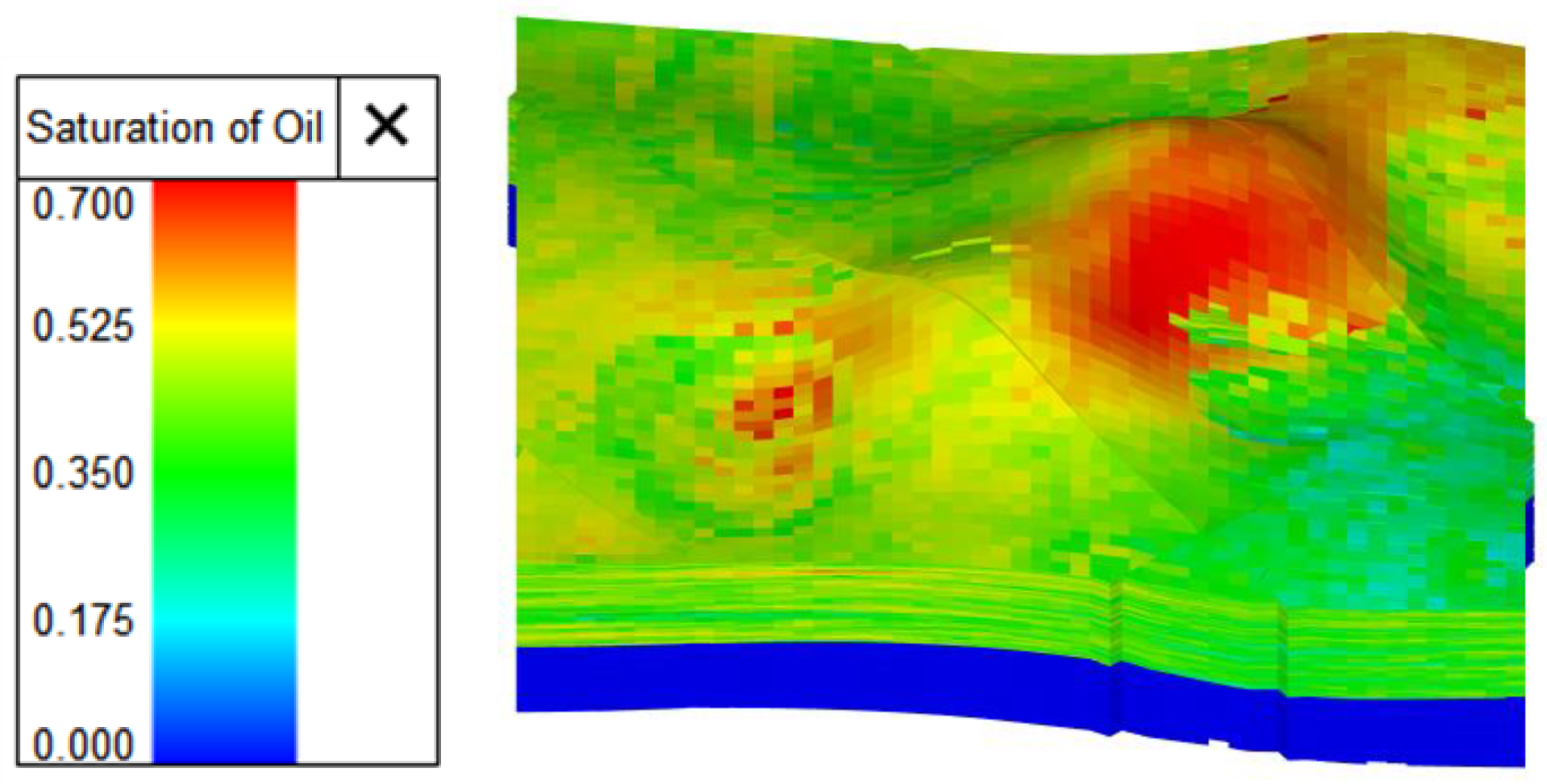
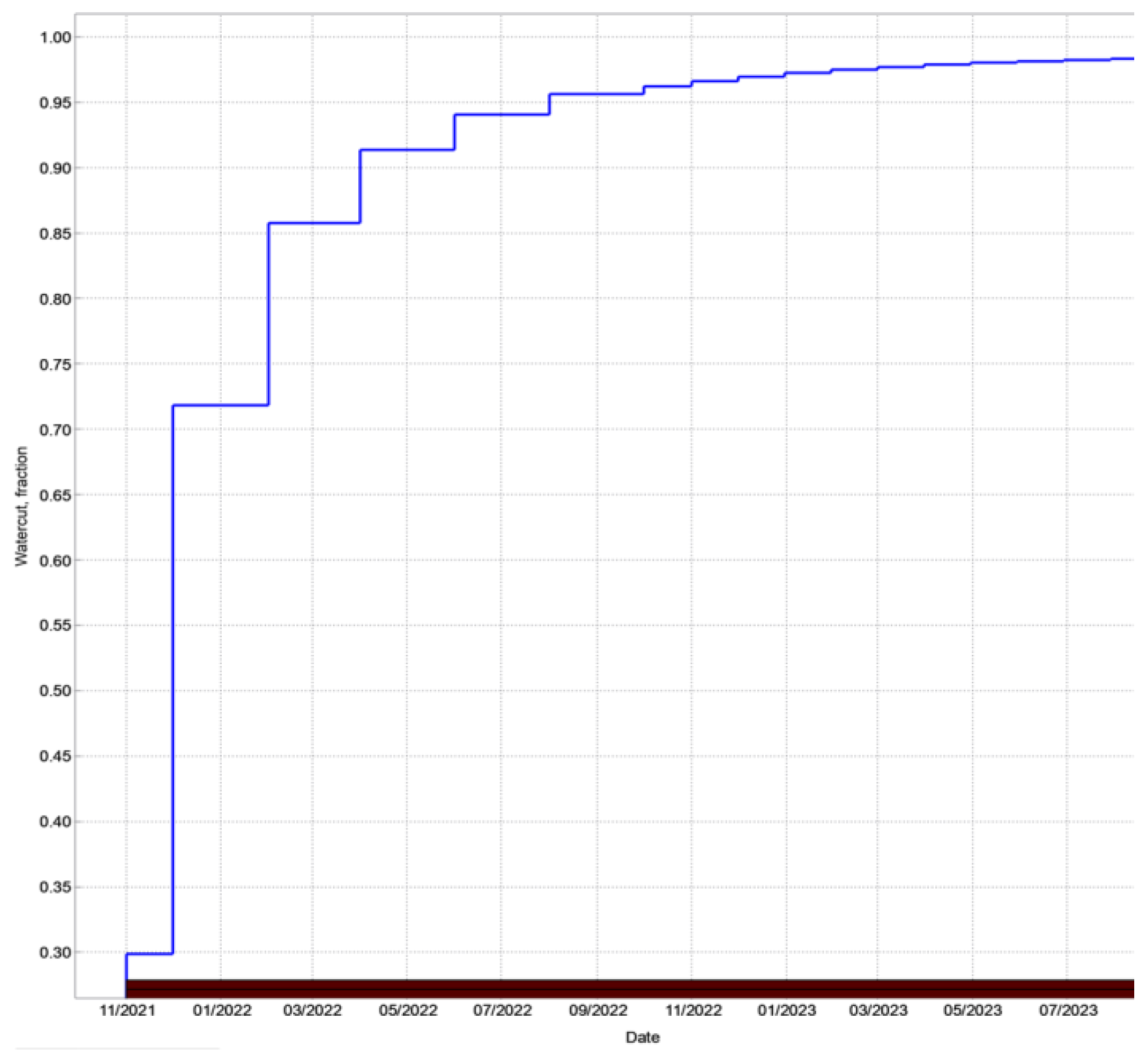



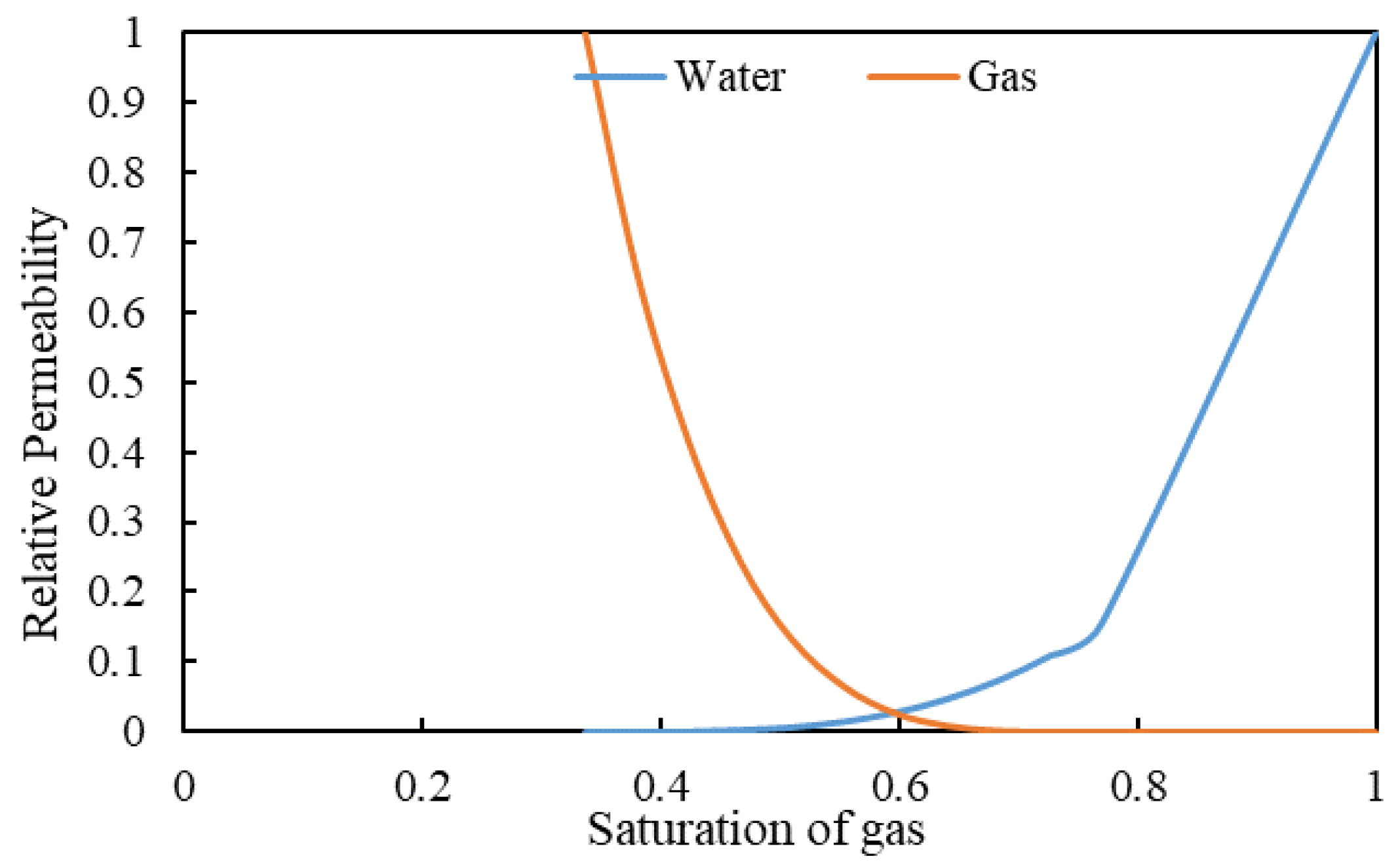
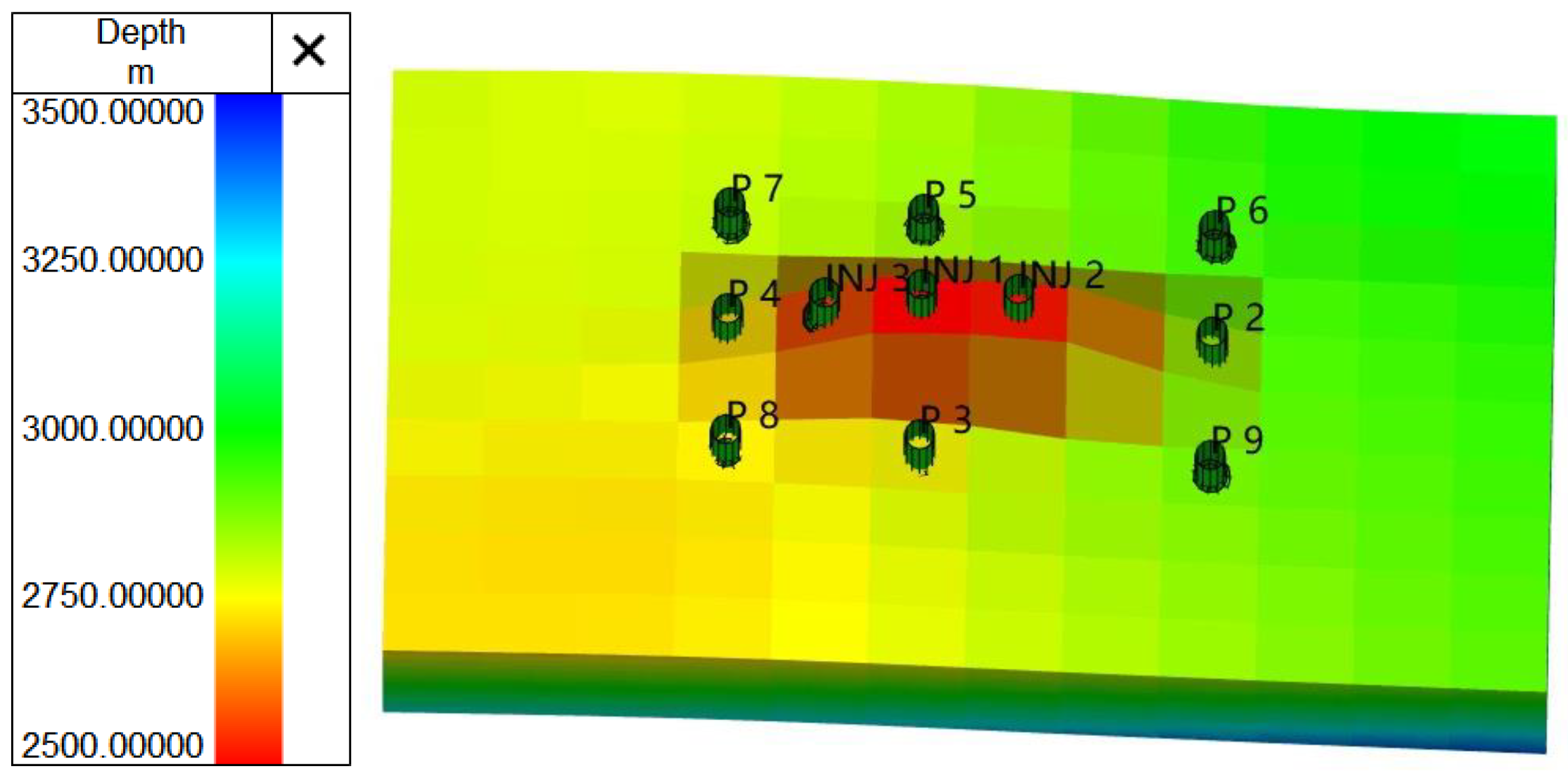



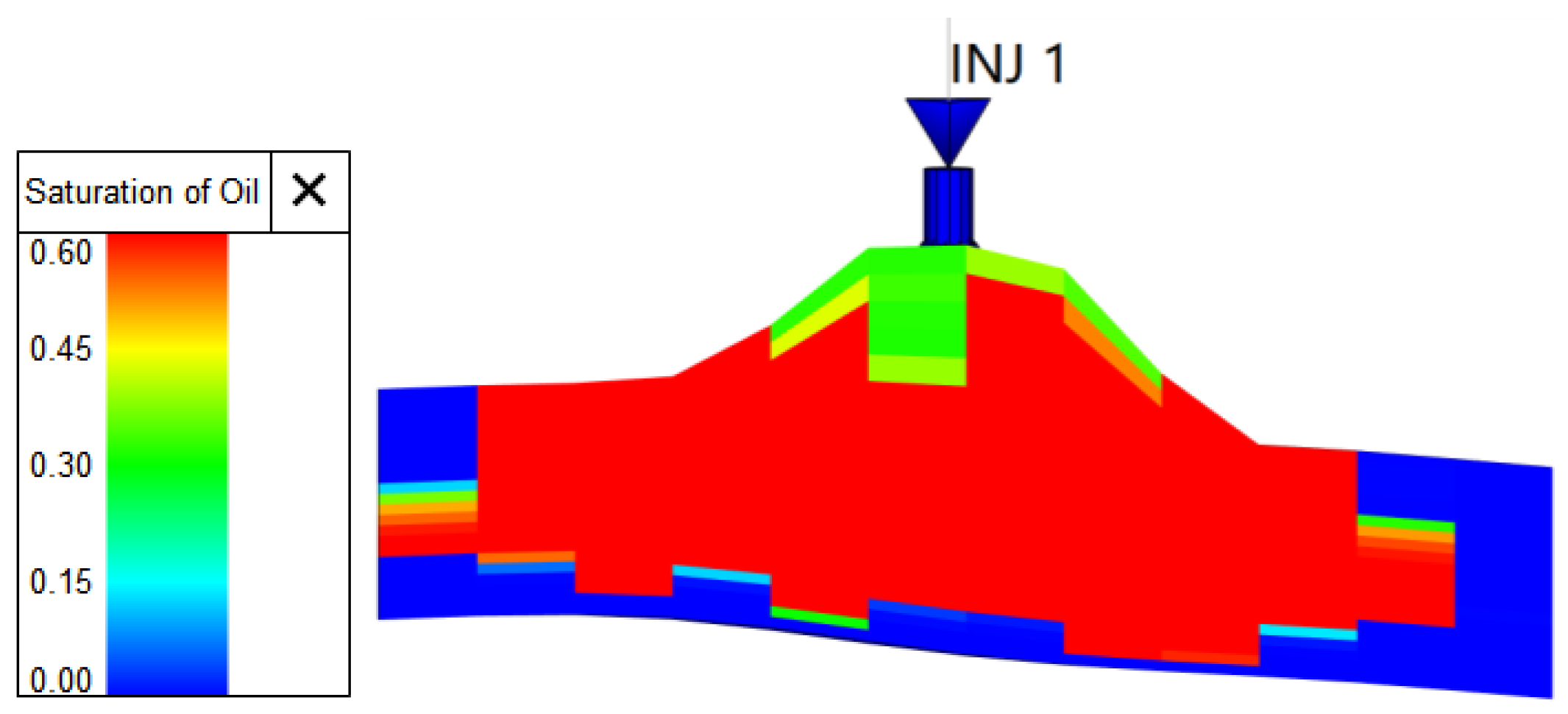
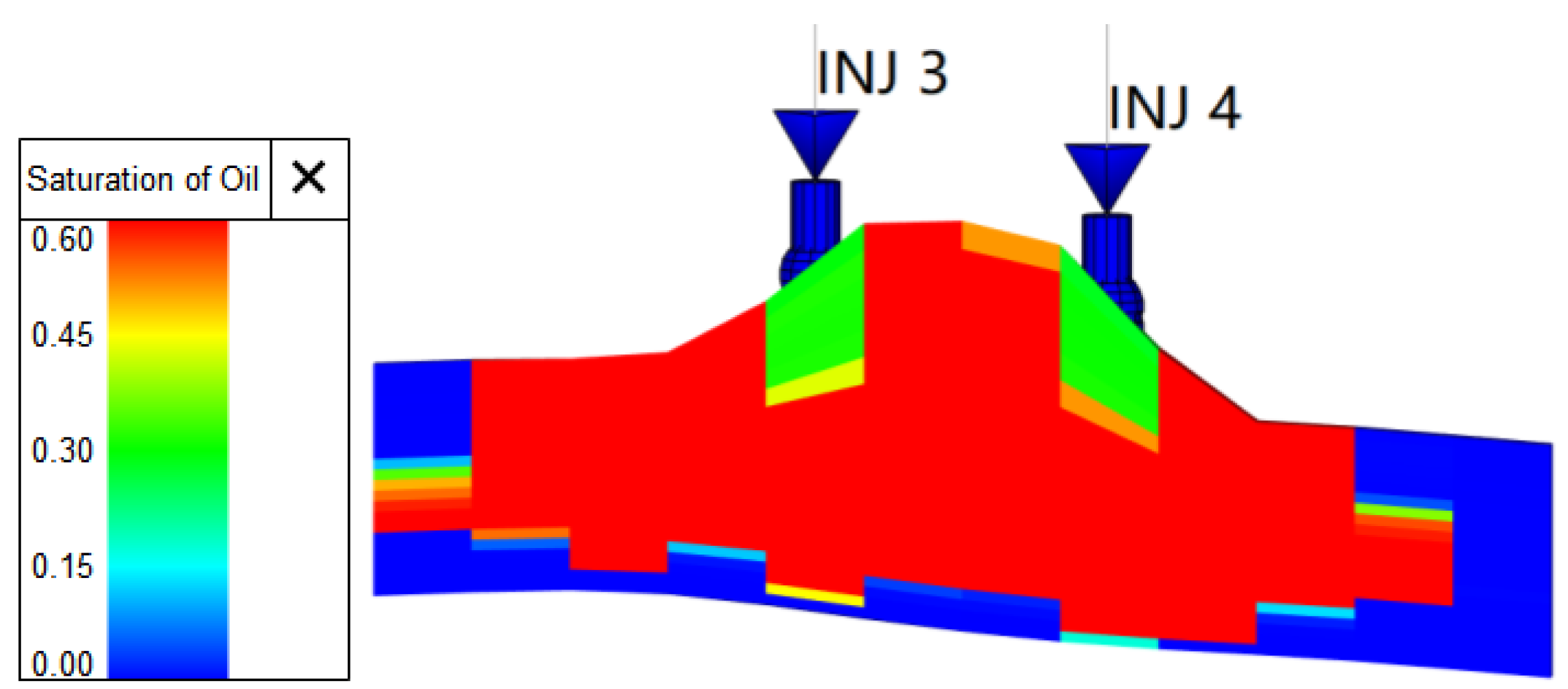
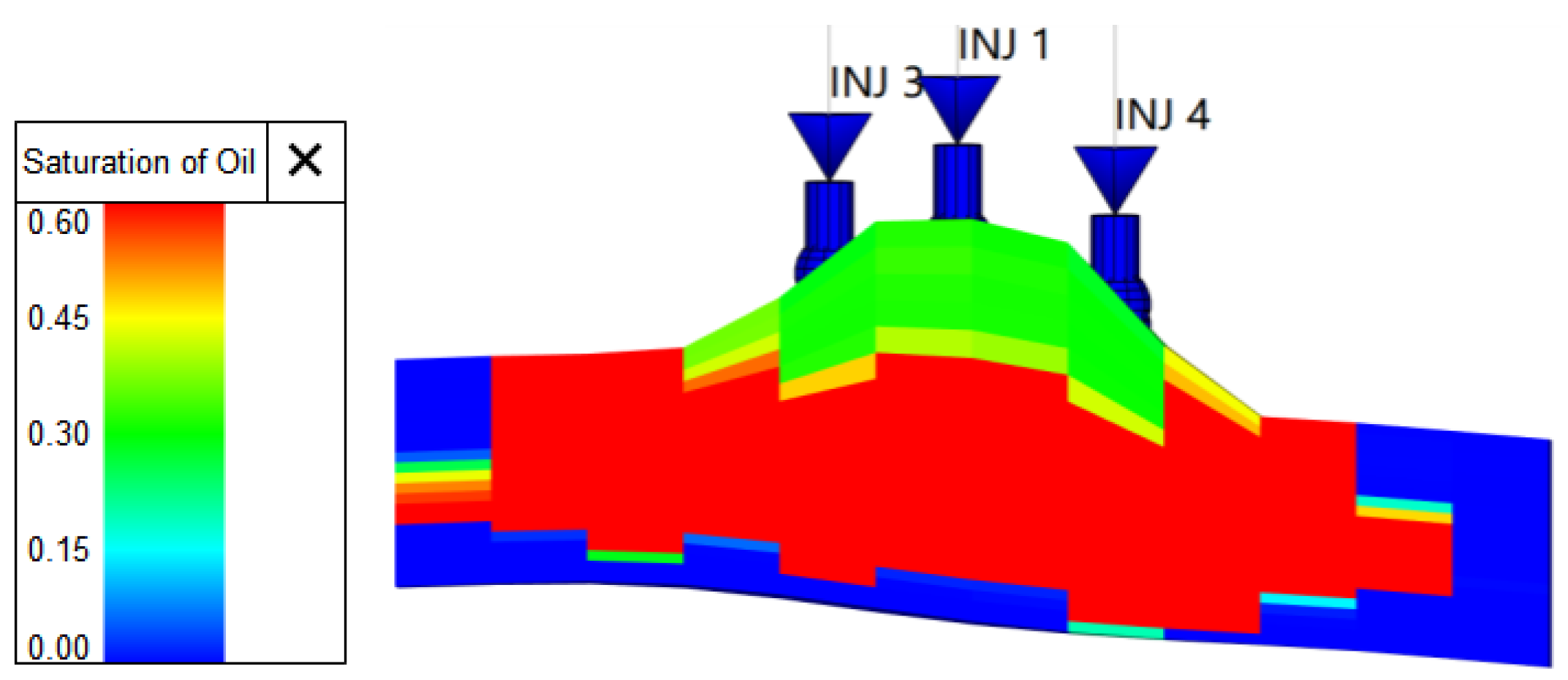
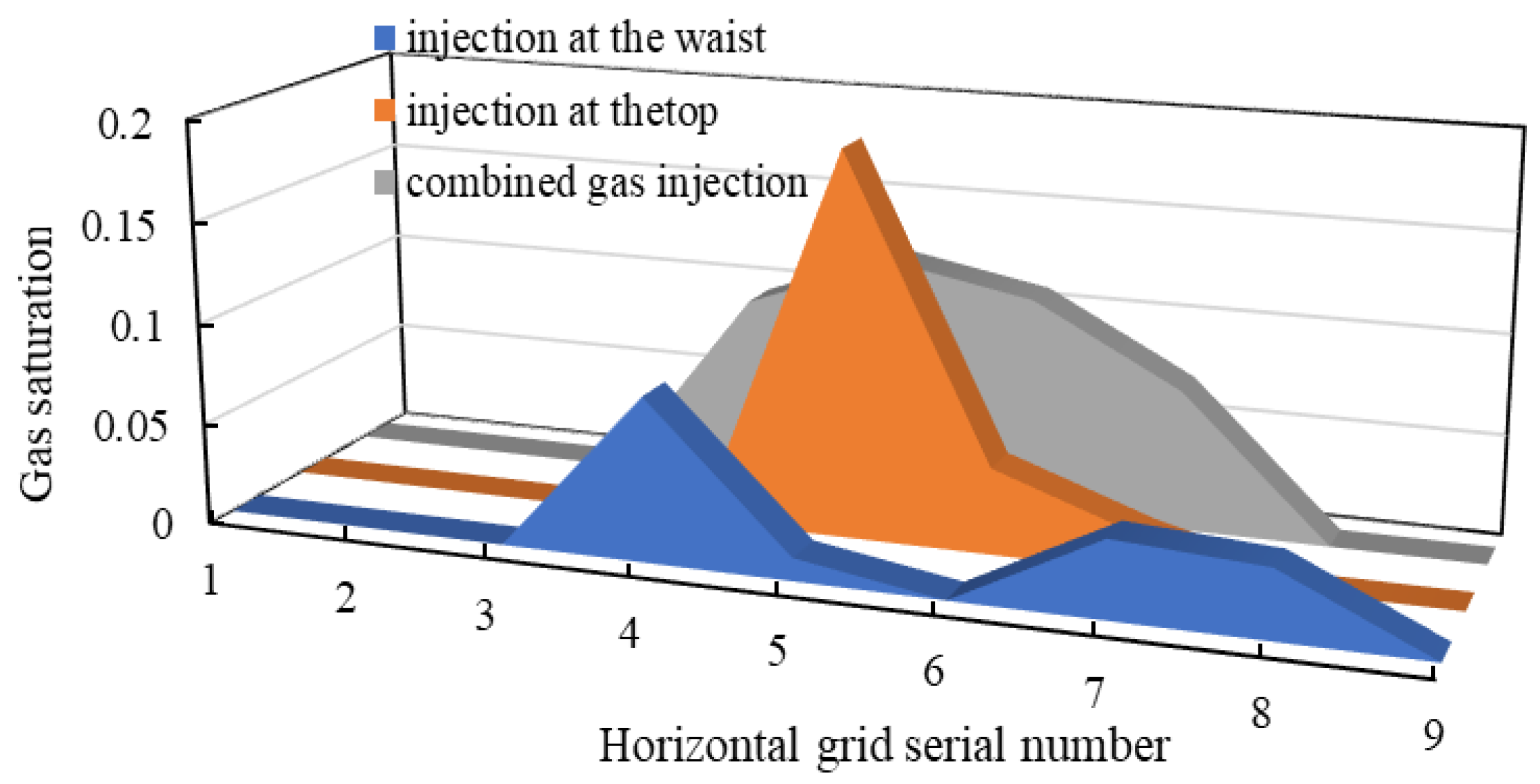

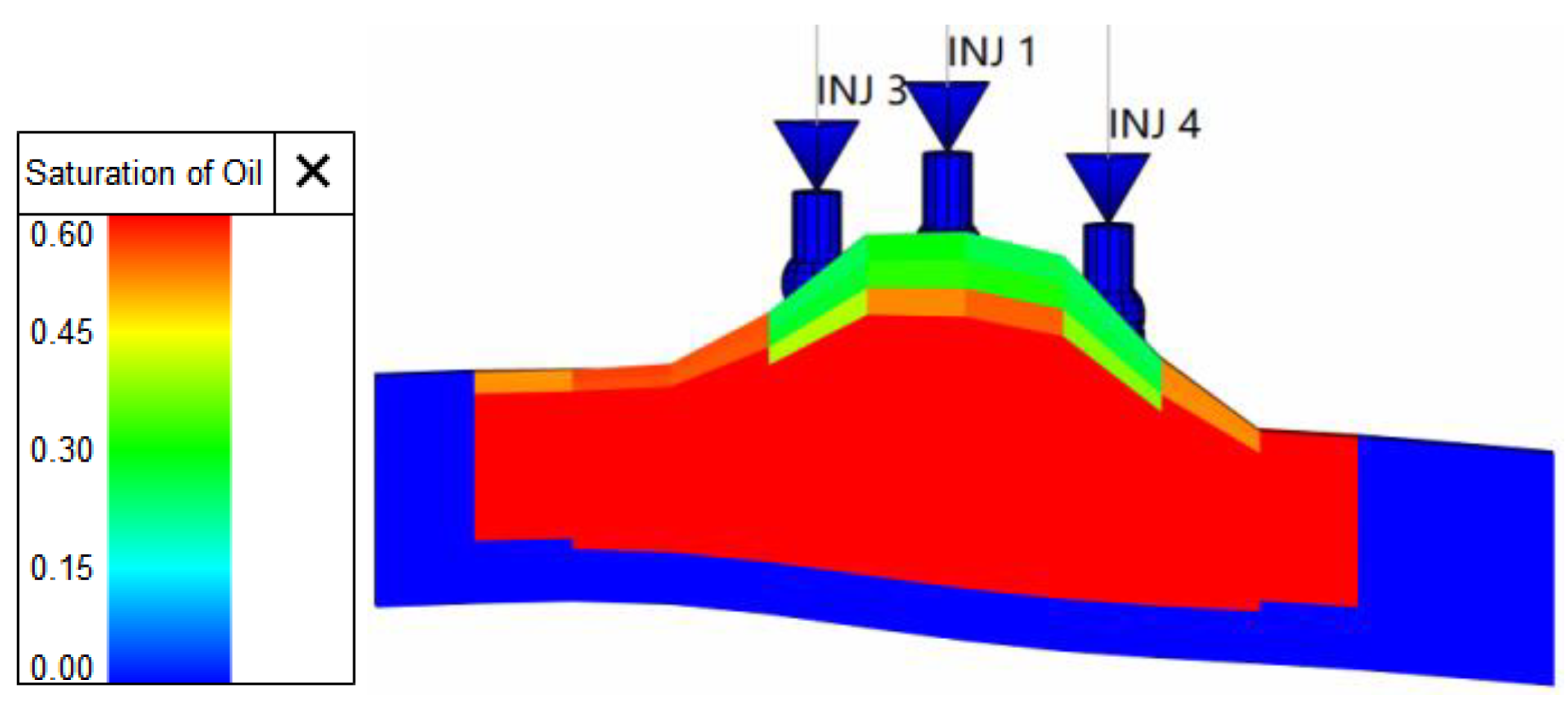





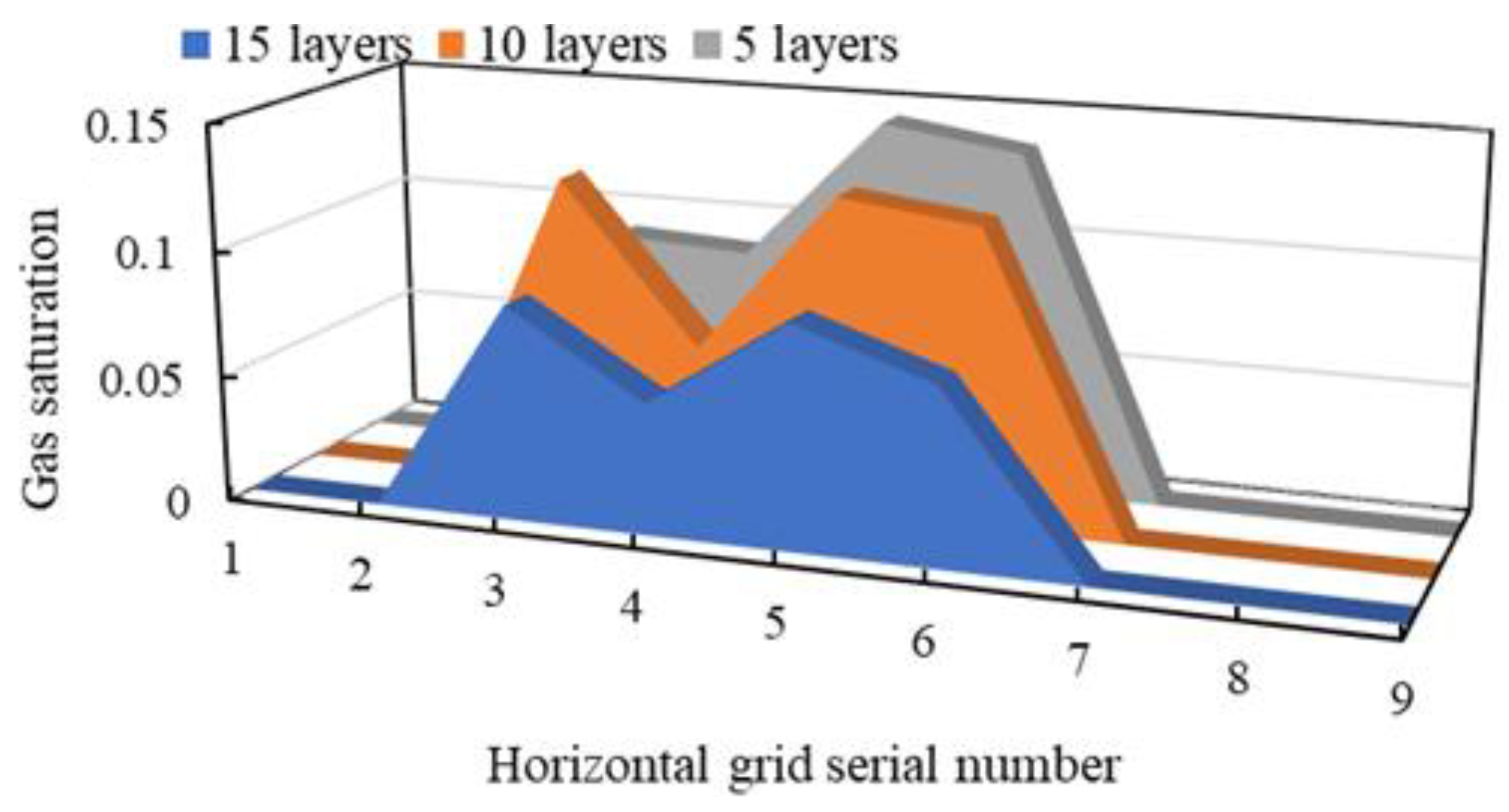


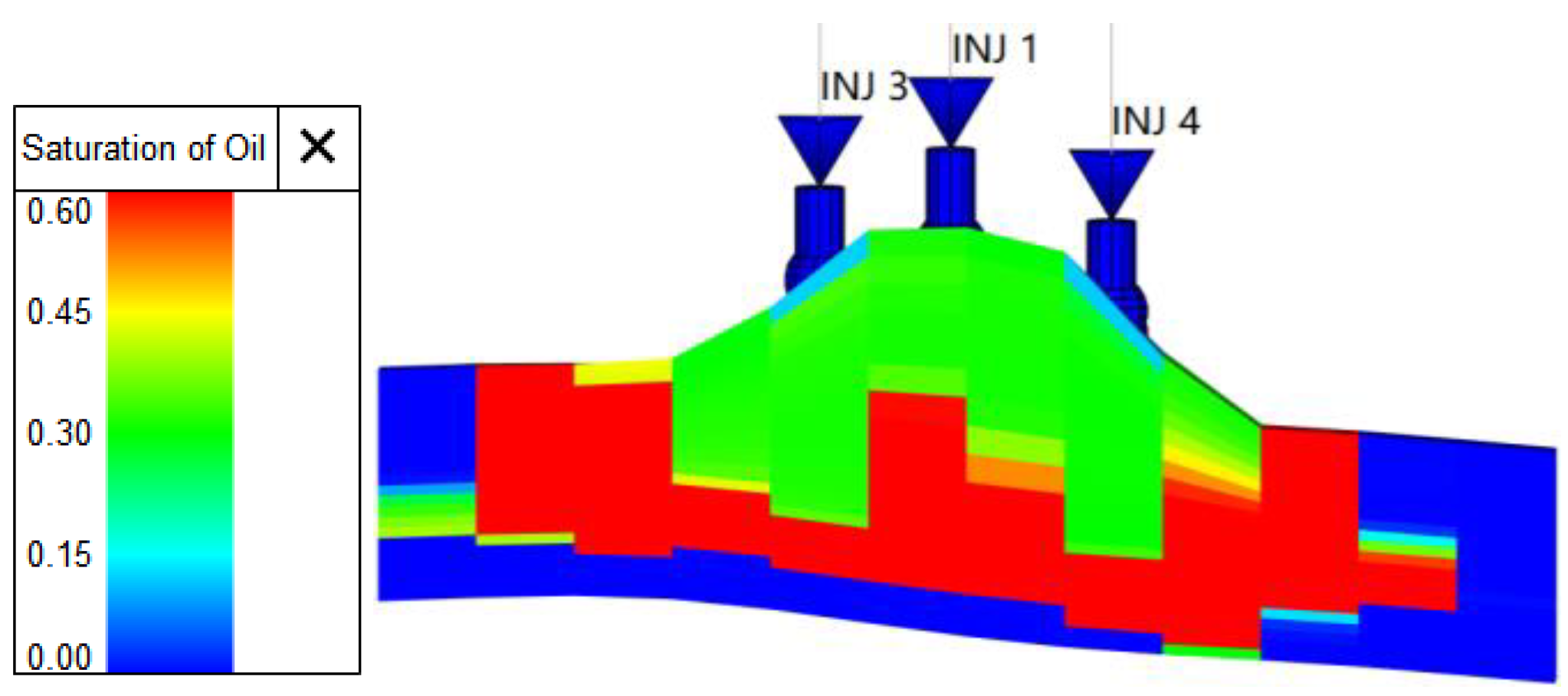
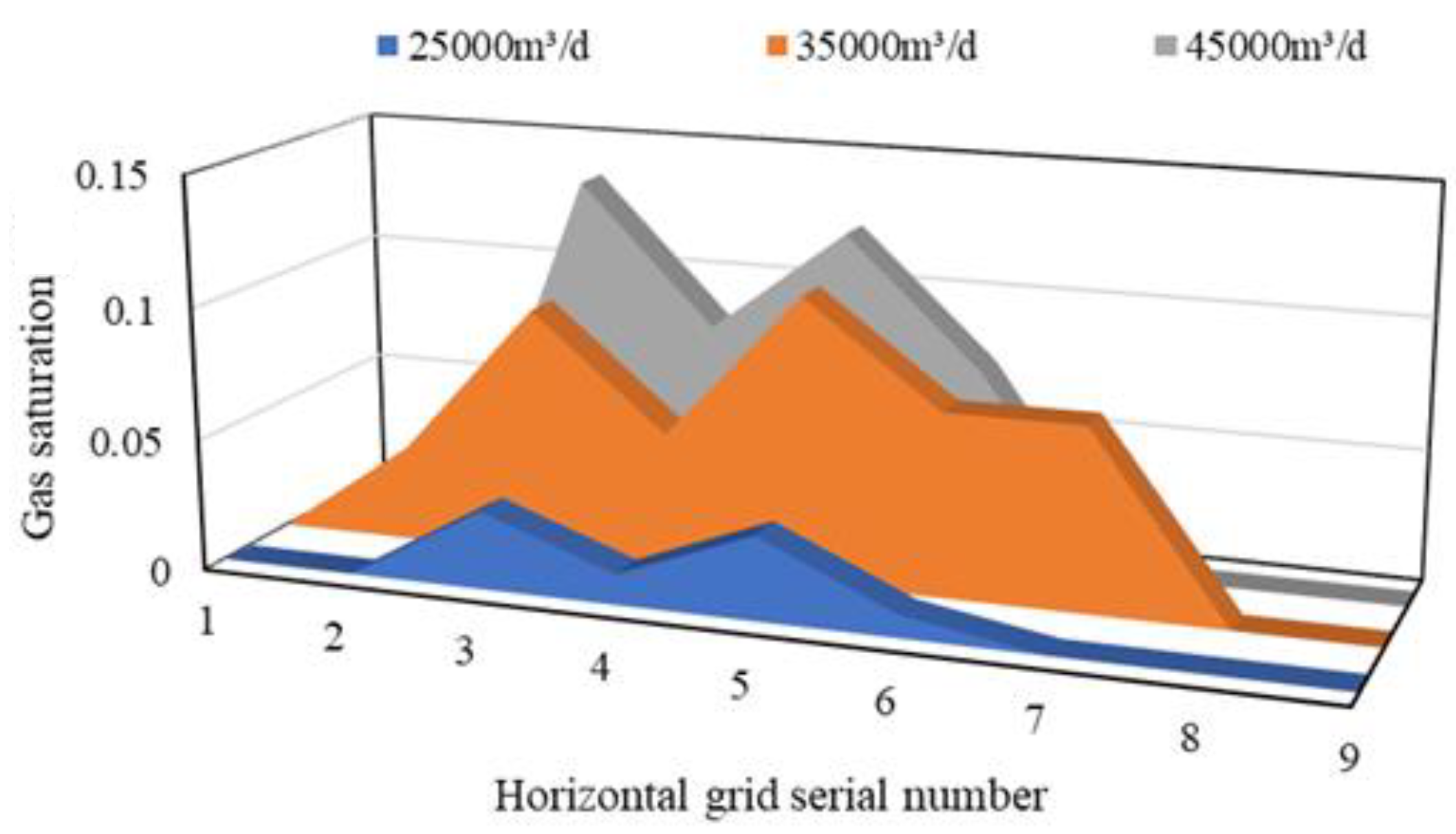

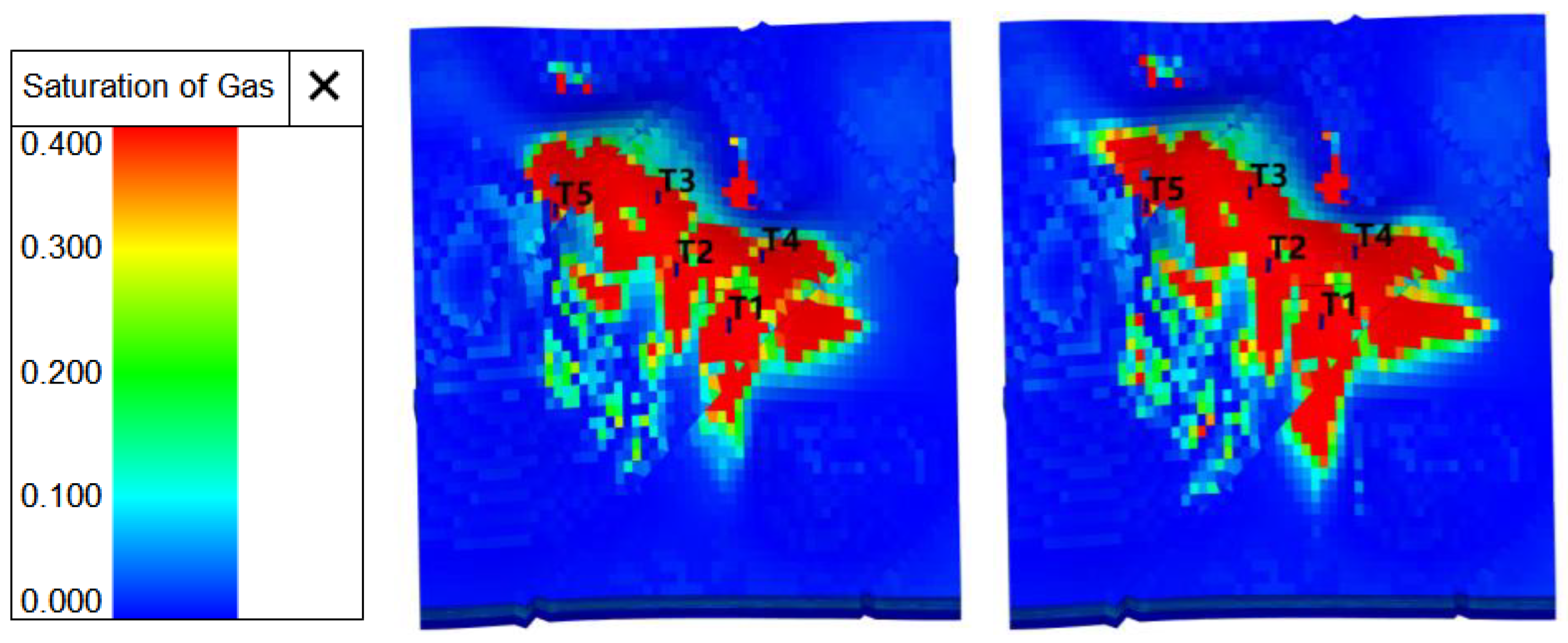
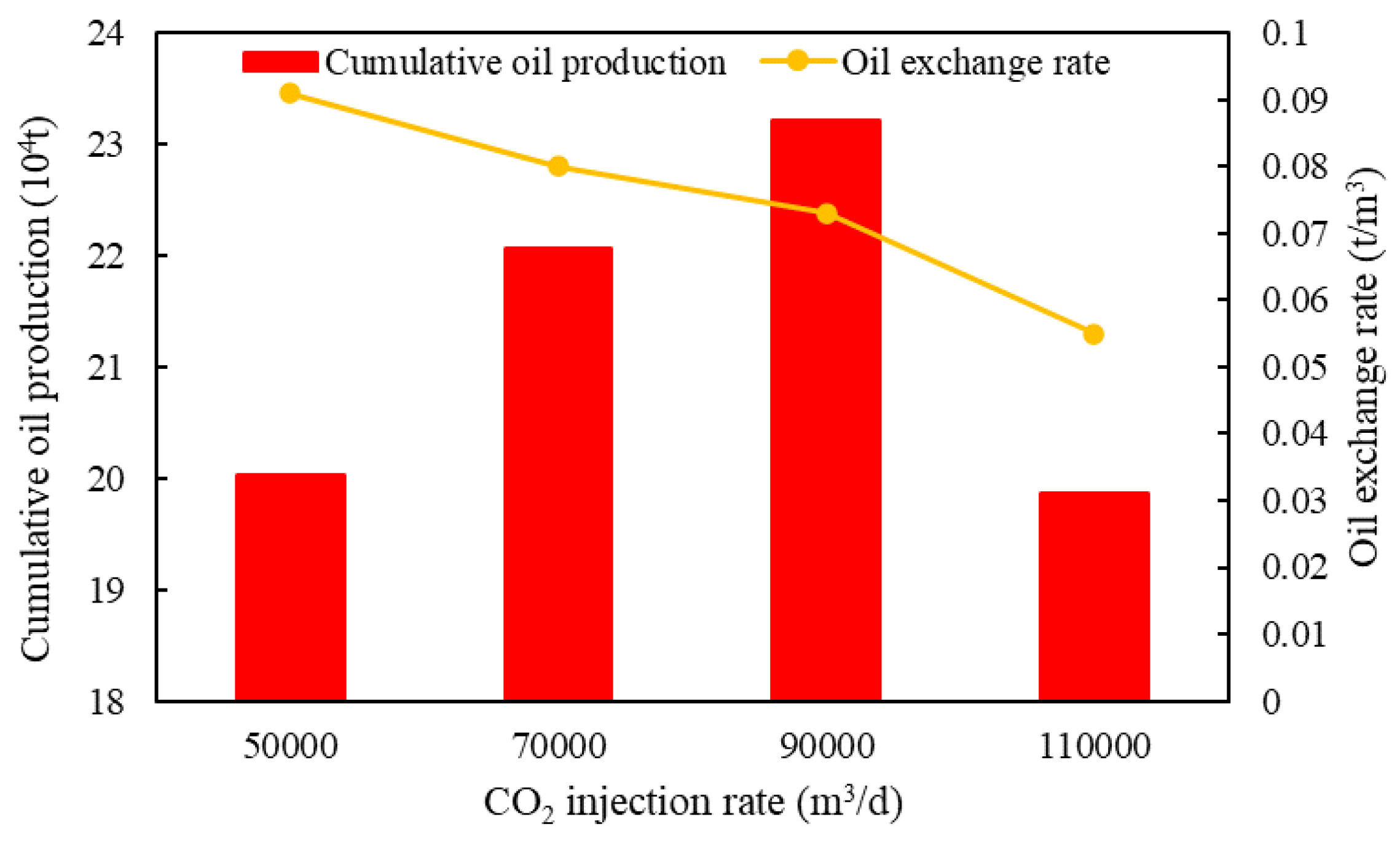


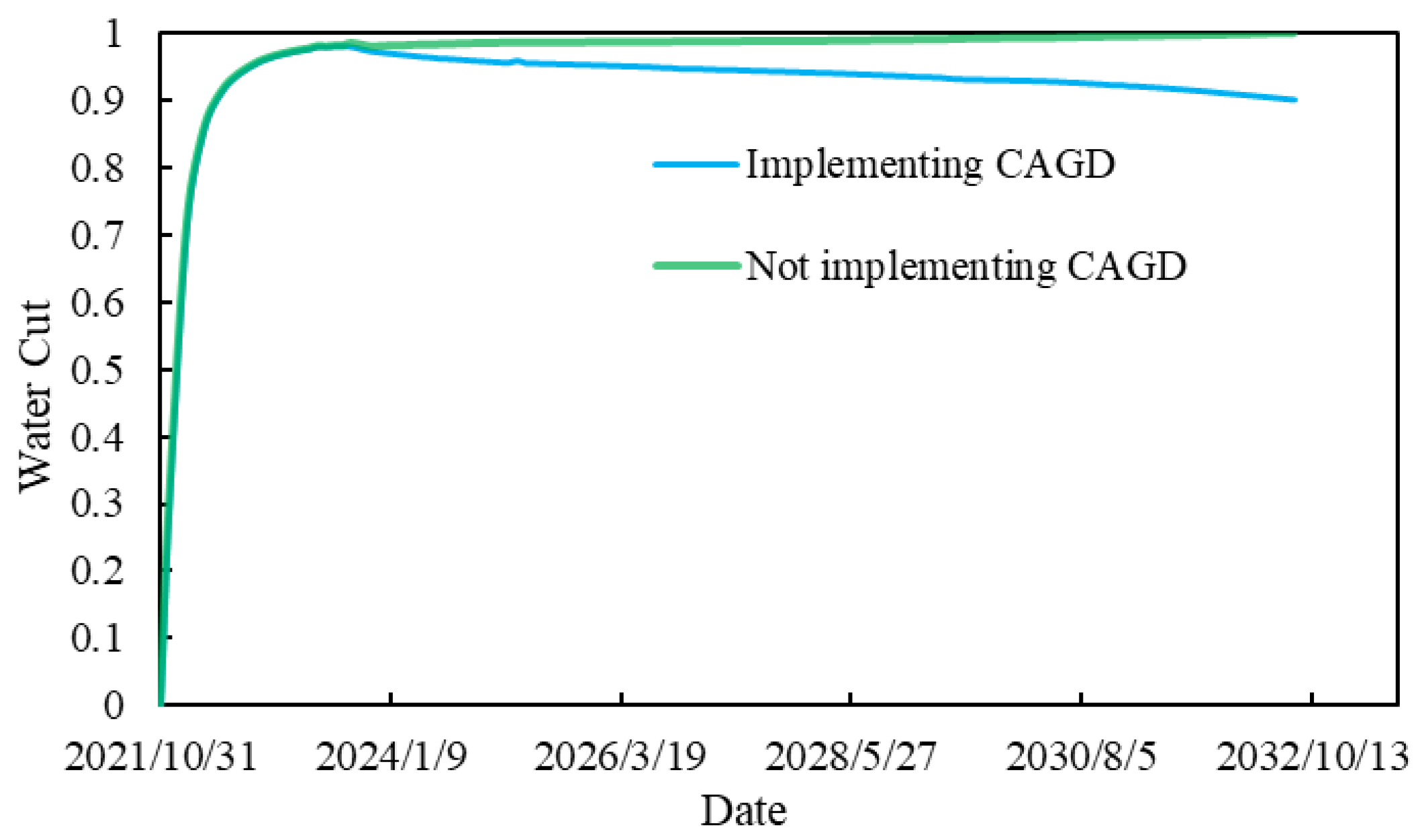
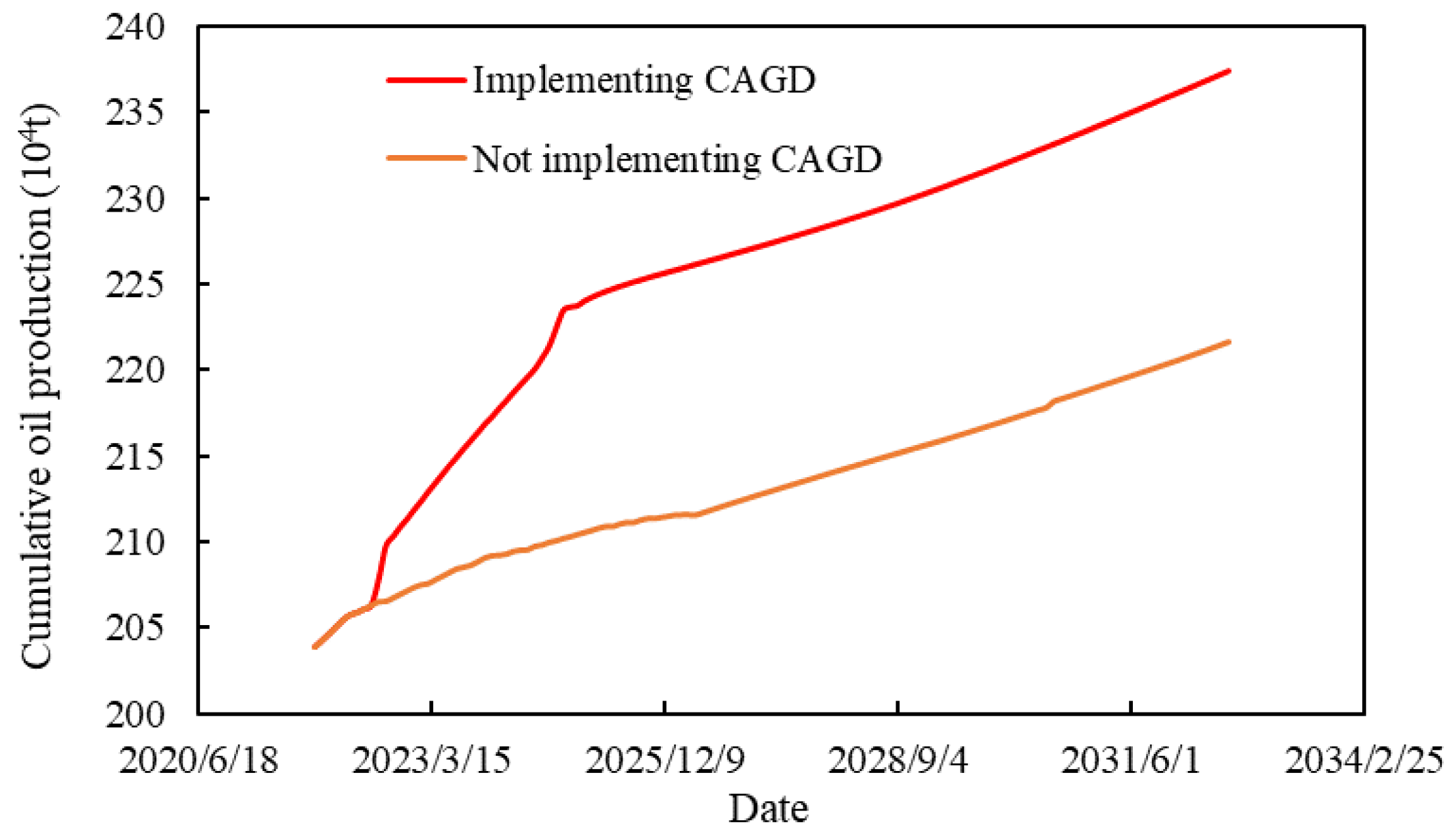
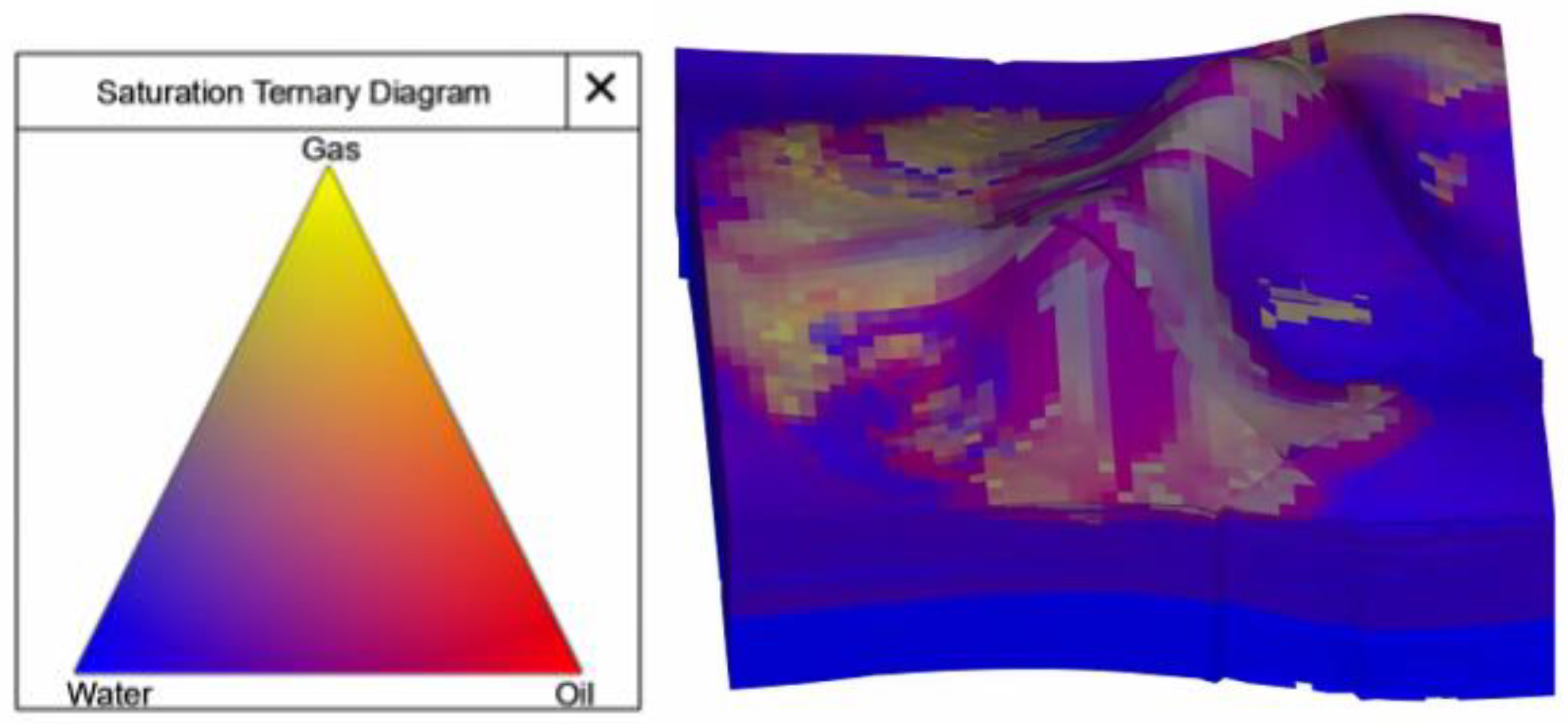

| Parameter | Numerical Value |
|---|---|
| grid number | 12 × 10 × 22 |
| grid size in X, Y, Z direction, m | 100, 100, 5 |
| Initial porosity, % | 15 |
| Initial permeability in X direction, mD | 20 |
| Initial permeability in Y direction, mD | 20 |
| Initial permeability in Z direction, mD | 20 |
| Initial oil-water interface, m | 3250 |
| Minimum miscible pressure, MPa | 22 |
| Rock compression coefficient, MPa−1 | 1.45 × 10−4 |
| Crude Oil Component | Molar Content (%) |
|---|---|
| N2 | 0.29 |
| CO2 | 1.17 |
| C1 | 53.78 |
| C2 | 6.93 |
| C3–6 | 8.14 |
| C7–17 | 22.50 |
| C18+ | 7.20 |
| Scheme | Gas Well Injection Mode | |
|---|---|---|
| 1 | Continuous gas injection | Monthly |
| 2 | Intermittent gas injection | Inject 4 months; stop for 2 months |
| Gas Injection Rate (m3/d) | Cumulative Oil Production (104 t) | Oil Exchange Rate (t/m3) |
|---|---|---|
| 50,000 | 200.264 | 0.091 |
| 70,000 | 220.625 | 0.080 |
| 90,000 | 232.185 | 0.073 |
| 110,000 | 198.717 | 0.055 |
| I-P Ratio | Cumulative Oil Production (104 t) |
|---|---|
| 0.7 | 207.064 |
| 0.8 | 214.269 |
| 0.9 | 224.357 |
| 1.0 | 232.185 |
| 1.1 | 235.185 |
Disclaimer/Publisher’s Note: The statements, opinions and data contained in all publications are solely those of the individual author(s) and contributor(s) and not of MDPI and/or the editor(s). MDPI and/or the editor(s) disclaim responsibility for any injury to people or property resulting from any ideas, methods, instructions or products referred to in the content. |
© 2023 by the authors. Licensee MDPI, Basel, Switzerland. This article is an open access article distributed under the terms and conditions of the Creative Commons Attribution (CC BY) license (https://creativecommons.org/licenses/by/4.0/).
Share and Cite
Lu, H.; Xin, X.; Ye, J.; Yu, G. Analysis of Factors Impacting CO2 Assisted Gravity Drainage in Oil Reservoirs with Bottom Water. Processes 2023, 11, 3290. https://doi.org/10.3390/pr11123290
Lu H, Xin X, Ye J, Yu G. Analysis of Factors Impacting CO2 Assisted Gravity Drainage in Oil Reservoirs with Bottom Water. Processes. 2023; 11(12):3290. https://doi.org/10.3390/pr11123290
Chicago/Turabian StyleLu, Hao, Xiankang Xin, Jinxi Ye, and Gaoming Yu. 2023. "Analysis of Factors Impacting CO2 Assisted Gravity Drainage in Oil Reservoirs with Bottom Water" Processes 11, no. 12: 3290. https://doi.org/10.3390/pr11123290




